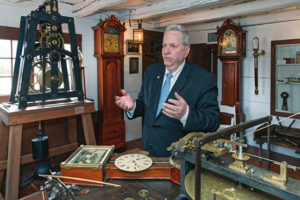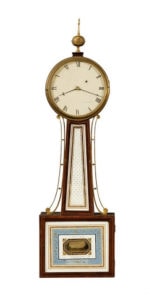By Christine Galeone, Contributing Writer

Grafton – If imitation is the sincerest form of flattery, renowned clockmaker Simon Willard should have been delighted when his peers began imitating the design of his popular banjo clock, shortly after he received a patent for it in 1802. But he wasn’t. Although he allowed clockmakers in his family and some of his apprentices to produce versions of the clock that resembled the stringed instrument, he was angered by the fakes that flooded the marketplace.
Even now, forgeries and fakes of the clock, which was also known as the “patent timepiece,” are being sold. Robert C. Cheney, executive director and curator of the Willard House and Clock Museum, proclaimed that the timepiece is “probably the most faked American clock found today.” And while it’s difficult to distinguish between many forgeries and authentic Willard clocks, he’s learned the secrets to identifying the genuine ones. On Sunday, Sept. 16, from 1-2 p.m. at museum, he’ll share those secrets in his lecture “Fakes, Forgeries and Marriages: The Pitfalls of Collecting Willard’s Patent Timepiece.”
Cheney is uniquely qualified to give the lecture. Not only did he serve as an appraiser on the PBS show “Antiques Roadshow” and provide services to more than 35 museums, he’s lectured on American clocks in the United States and abroad. He’s also a third-generation clockmaker.
Banjo clocks played an important role in his life. Because they have an elegant simplicity, Cheney’s dad taught his young son the craft of making and restoring clocks by using projects involving them.
“They are some of the easiest clocks to repair,” Cheney said. “By age 7, I had disassembled and cleaned a patent timepiece for a major museum.”
Cheney has uncovered hundreds of banjo clock frauds. And with some clocks selling for up to $250,000 each, collectors and museums want to be as certain as possible that they’re not buying forgeries.
Cheney said that not too many years ago, a highly skilled central Massachusetts hobbyist created a reproduction that he convinced people was a genuine banjo clock. When he passed away, it ended up in the hands of an antiques dealer who tried to sell it for $85,000.
“It wasn’t Simon Willard, but it did sure look like a Willard,” Cheney recalled.
In some cases, it’s the glass that fools people. Cheney said that when some collectors see glass that has imperfections and appears to be aged, they assume the clocks are genuine. But, he said, in the 19th century, clockmakers used “the best glass they could find,” because they wanted ideal surfaces to do reverse painting of ornate designs. Learning to recognize the difference between good glass and bad glass – without the aid of tools like black light – is one of the things he’ll discuss.
Cheney, who was recently awarded the National Association of Watch and Clock Collectors’ Silver Star Fellow designation (its highest award), is looking forward to giving the lecture.
“In this lecture, I’m going to open the faker’s handbook,” he said, “and I’m going to give away secrets that have been kept under wraps for years.”
The Willard House and Clock Museum is located at 11 Willard Road, North Grafton.

















